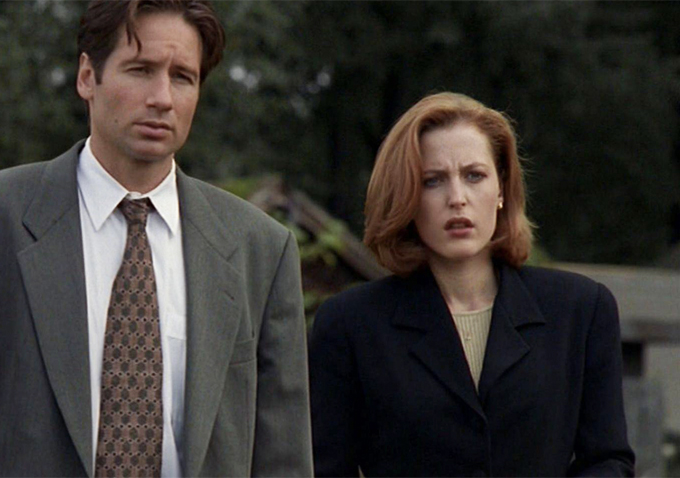By providing your information, you agree to our Terms of Use and our Privacy Policy. We use vendors that may also process your information to help provide our services. This site is protected by reCAPTCHA Enterprise and the Google Privacy Policy and Terms of Service apply.
7 Groundbreaking ‘X-Files’ Episodes To Celebrate UFO Day

IndieWire Staff

Today marks the anniversary of the Roswell UFO crash in 1947, and whether you believe in flying saucers or weather balloons, there’s no denying the event sparked something profound in the American imagination.
Perhaps most importantly for TV fans, the alien conspiracies triggered by the event were a direct inspiration for “The X-Files,” which spent nine seasons following Agents Mulder (David Duchovny) and Scully (Gillian Anderson) as they searched for The Truth. While the series had its uneven patches, it featured some moments of truly ground-breaking television which paved the way for the revolution in quality that came in later years. Below are some of the episodes that best encapsulate those ideals.
“Jose Chung’s ‘From Outer Space'” (Season 3)
Writer Darin Morgan only contributed a few episodes to “The X-Files” during its second and third seasons, but the four credited to him are some of the most landmark of the series. “Jose Chung” may be his most notable accomplishment, a bold experiment in point-of-view. Charles Nelson Reilly gives Anderson and Duchovny a bit of a break by starring as the eccentric writer Jose Chung, who’s trying to uncover the truth behind a series of strange abductions but instead encounters half-truths, conflicting stories and Jesse Ventura. One of the series’ funniest episodes, yet ends with a montage that is still moving in its sincerity. (Liz Shannon Miller)
“Home” (Season 4)

“Post-Modern Prometheus” (Season 5)
When you run your own TV show, and it’s one of the most popular on your network, you can get away with a lot — up to and including an elaborate “Frankenstein” pastiche filmed entirely in black-and-white, set to the music of Cher. Viewed today, there are some questionable consent issues that come up, but it was a bold diversion from the standard “X-Files” format, one that showed the show’s willingness to take chances and experiment. The ending is easily one of the strangest and most random in the show’s history, but somehow its weirdness proves charming. (Liz Shannon Miller)
“Triangle” (Season 6)
After the mythology-heavy movie “Fight the Future” came out in the summer of 1998, the series’ sixth season explored a bit more humor in its monster-of-the-week episodes. “Triangle” was the season’s third episode, and the first to explore this increase in comedic content. When Mulder heads to the Bermuda Triangle to check out the recently reappeared Queen Anne, a luxury liner that had disappeared in 1939, Scully and the Lone Gunmen head after him. But as Mulder and Scully simultaneously explore the same ship, it becomes clear that they’re not in the same time. “Triangle” was inspired by Alfred Hitchcock’s film “Rope,” and utilized editing techniques that make several scenes appear as if they had been shot in one long, singular take. The episode also used its spectacular cast in double roles, having William B. Davis (The Smoking Man) and Mitch Pileggi (Skinner) play Nazi soldiers and Gillian Anderson as a wise-cracking OSS spy with a mean right hook. “Triangle” paved the way for the series to take more comedic risks which resulted in episodes like “Dreamland Parts 1 & 2,” “Arcadia” and “Hollywood AD.” (Casey Ciprani)
“The Unnatural” (Season 6)

“Hungry” (Season 7)
“The X-Files” developed a solid formula of mixing plot-heavy mythology episodes with stand-alone “monster of the week” installments, but as future “Breaking Bad” creator Vince Gilligan proved here, there was plenty of room for creativity within that format. Instead of Mulder and Scully investigating the monster, “Hungry” is told through the monster’s point-of-view — making the monster into the episode’s extremely sympathetic anti-hero. Imagine Walter White, except he eats brains. (Actually, that’s not too much of a stretch.) (Liz Shannon Miller)
“John Doe” (Season 9)
Season 9 is rarely remembered fondly by hardcore “X-Files” fans, but it does include a few highlights — including the directorial debut of Michelle MacLaren, who graduated to the directing chair with this visually stylish one man show for Robert Patrick. Set largely in Mexico, “John Doe” features some innovative cinematography that sets it apart from other episodes of the series, and proved to be an able launching ground for MacLaren’s career: She’s since gone on to direct episodes of “Breaking Bad,” “Game of Thrones,” “The Leftovers” and “The Walking Dead.” Without “John Doe,” today’s TV landscape might look pretty different. (Liz Shannon Miller)
This article was updated to correct the year of the Roswell sightings.
By providing your information, you agree to our Terms of Use and our Privacy Policy. We use vendors that may also process your information to help provide our services. This site is protected by reCAPTCHA Enterprise and the Google Privacy Policy and Terms of Service apply.

















